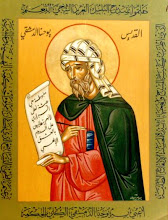Byzantine Catholics began Lent two days ago with Clean Monday (see previous posts), and today Roman Catholics commence their Lenten journey with Ash Wednesday. (As a quick reminder, the methods of accounting the days differ and the degree of fasting and abstinence on Sundays varies, in addition to Byzantine Christians accounting Holy Week as its own fast.)
Pope Benedict released his annual Message for Lent yesterday. Through his emphasis on Divine Love (recall his first Encyclical Deus Caritas Est) and deft quoting of the Fathers, his message embraces both the Eastern and Western views on the Fast. Both the Encyclical and the Lenten Message are worth reading, especially for those seeking material for spiritual reflection during the Fast.
A couple of excerpts from the Message for Lent 2007 follow:
It is in the mystery of the Cross that the overwhelming power of the heavenly Father’s mercy is revealed in all of its fullness. In order to win back the love of His creature, He accepted to pay a very high price: the blood of His only begotten Son. Death, which for the first Adam was an extreme sign of loneliness and powerlessness, was thus transformed in the supreme act of love and freedom of the new Adam. One could very well assert, therefore, together with Saint Maximus the Confessor, that Christ “died, if one could say so, divinely, because He died freely” (Ambigua, 91, 1956). On the Cross, God’s eros for us is made manifest. Eros is indeed – as Pseudo-Dionysius expresses it – that force “that does not allow the lover to remain in himself but moves him to become one with the beloved” (De divinis nominibus, IV, 13: PG 3, 712). Is there more “mad eros” (N. Cabasilas, Vita in Cristo, 648) than that which led the Son of God to make Himself one with us even to the point of suffering as His own the consequences of our offences?
“They shall look on Him whom they have pierced.” Let us look with trust at the pierced side of Jesus from which flow “blood and water” (Jn 19:34)! The Fathers of the Church considered these elements as symbols of the sacraments of Baptism and the Eucharist. Through the water of Baptism, thanks to the action of the Holy Spirit, we are given access to the intimacy of Trinitarian love. In the Lenten journey, memorial of our Baptism, we are exhorted to come out of ourselves in order to open ourselves, in trustful abandonment, to the merciful embrace of the Father (cf. Saint John Chrysostom, Catecheses, 3,14ff). Blood, symbol of the love of the Good Shepherd, flows into us especially in the Eucharistic mystery: “The Eucharist draws us into Jesus’ act of self-oblation … we enter into the very dynamic of His self-giving” (Encyclical Deus caritas est, 13). Let us live Lent then, as a “Eucharistic” time in which, welcoming the love of Jesus, we learn to spread it around us with every word and deed.
To all our Roman brothers and sisters who are joining us today in the great Lenten voyage to Pascha we say: Welcome aboard! Let us walk this path in peace together.
Wednesday, February 21, 2007
Subscribe to:
Post Comments (Atom)


No comments:
Post a Comment